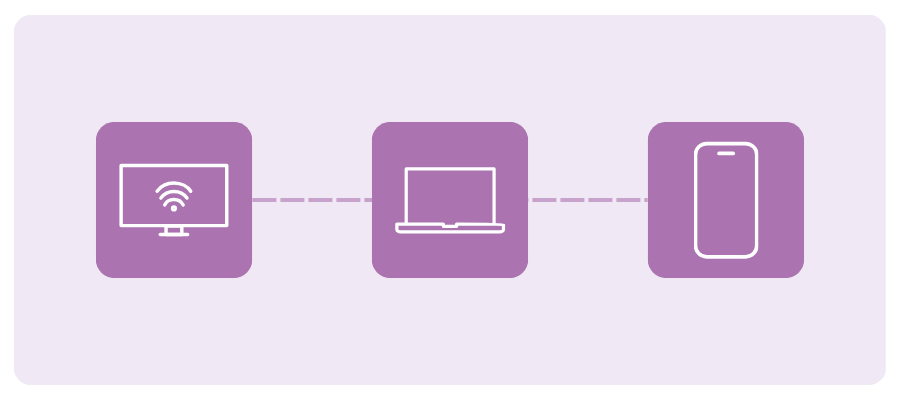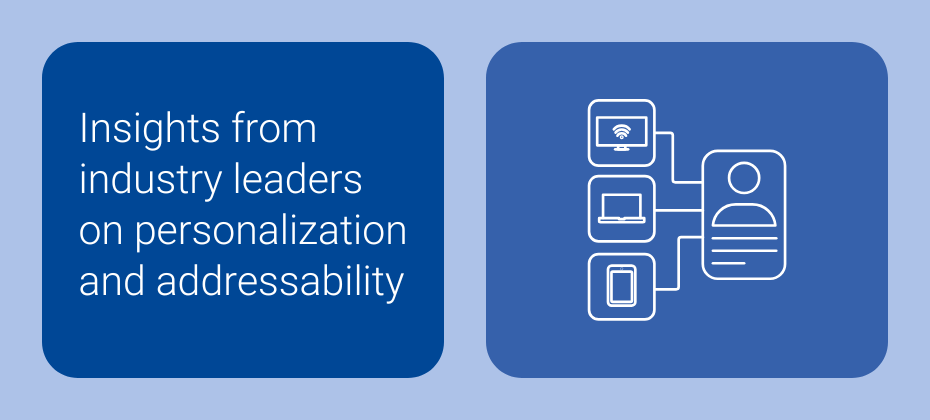At A Glance
Infillion and Experian collaborate to help advertisers connect with audiences across devices and channels, as cookies and mobile identifiers disappear. By integrating Experian's Digital Graph and Offline Identity Resolution, Infillion strengthens identity connections, improves campaign reach, and enhances audience engagement across CTV, mobile, and web.In our Ask the Expert Series, we interview leaders from our partner organizations who are helping lead their brands to new heights in AdTech. Today’s interview is with Ben Smith, VP of Product, Data Products at Infillion.
Adapting to signal loss
What does the Experian–Infillion integration mean for advertisers looking to reach audiences as signals fade?

As cookies and mobile identifiers disappear, brands need a new way to find and reach their audiences. The Experian integration strengthens Infillion’s XGraph, a cookieless, interoperable identity graph that supports all major ID frameworks, unifying people and households across devices with privacy compliance, by providing a stronger identity foundation with household- and person-level data. This allows us to connect the dots deterministically and compliantly across devices and channels, including connected TV (CTV). The result is better match rates on your first-party data, more scalable reach in cookieless environments, and more effective frequency management across every screen.
Connecting audiences across channels
How does Experian’s Digital Graph strengthen Infillion’s ability to deliver addressable media across channels like CTV and mobile?

Experian strengthens the household spine of XGraph, which means we can accurately connect CTV impressions to the people and devices in that home – then extend those connections to mobile and web. This lets us plan, activate, and measure campaigns at the right level: household for CTV, and person or device for mobile and web. The outcome is smarter reach, less waste from over-frequency, and campaigns that truly work together across channels.
The value of earned attention
Infillion has long championed “guaranteed attention” in advertising. How does that philosophy translate into measurable outcomes for brands?

Our engagement formats, such as TrueX, are based on a simple principle: attention should be earned, not forced. Viewers choose to engage with the ad and complete an action, which means every impression represents real, voluntary attention rather than passive exposure. Because of that, we consistently see stronger completion rates, deeper engagement, and clearer downstream results – like lower acquisition costs, improved on-site behavior, and measurable brand lift.
To take that a step further, we measure attention through UpLift, our real-time brand lift tool. UpLift helps quantify how exposure to a campaign influences awareness, consideration, or purchase intent, providing a more complete picture of how earned attention translates into business impact.
Creative innovation and location insights
Beyond identity resolution, what are some of Infillion’s capabilities, like advanced creative formats or location-based insights, that set you apart in the market?

One key area is location intelligence, which combines privacy-safe geospatial insights with location-based targeting through our proprietary geofencing technology. This allows us to build custom, data-driven campaigns that connect media exposure to real-world outcomes – like store visits and dwell time – measured through Arrival, our in-house footfall attribution product.
We also build custom audiences using a mix of zero-party survey data, first-party location-based segments, and bespoke audience builds aligned to each advertiser’s specific strategy.
Then there’s creative innovation, which is a major differentiator for us. Our high-impact formats go beyond static display, such as interactive video units that let viewers explore products through hotspots or carousels, rich-media ads that feature polls, quizzes, dynamic distance, or gamified elements, and immersive experiences that encourage active participation rather than passive viewing. These creative formats not only capture attention but also generate deeper engagement and stronger performance for a variety of KPIs.
Future ready media strategies
How does Infillion’s ID-agnostic approach help brands future-proof their media strategies amid ongoing privacy and tech changes?

We don’t put all our eggs in one basket. XGraph securely unifies multiple durable identifiers alongside our proprietary TrueX supply to strengthen CTV household reach. This agnostic design allows us to adapt as platforms, regulations, and browsers evolve – so you can preserve reach and measurement capabilities without getting locked into a single ID or losing coverage when the next signal deprecates.
Raising the bar for media accountability
Looking ahead, how is Infillion evolving its platform to meet the next wave of challenges in audience engagement and media accountability?
From an engagement standpoint, we’re expanding our ability to support the full customer journey, offering ad experiences that move seamlessly from awareness to consideration to conversion. That includes smarter creative that adapts to context, intelligent targeting and retargeting informed by real data, and formats designed to drive measurable outcomes rather than just impressions.
When it comes to accountability, we’re ensuring that measurement is both flexible and credible. In addition to our proprietary tools, we partner with leading third-party measurement providers to validate results and give advertisers confidence that their investment is truly performing. Within our DSP, we emphasize full transparency and log-level data access, ensuring advertisers can see exactly what’s happening on every impression.
All of this builds toward the next era of agentic media buying – one enabled by our MCP suite and modular, component-based tools. This evolution brings greater accountability and next-generation audience engagement to an increasingly automated, intelligent media landscape. Our goal is to help brands connect more meaningfully with audiences while holding every impression – and every outcome – to a higher standard of transparency and effectiveness.
Driving impact across the funnel
What is a success story or use cases that demonstrate the impact of the Experian–Infillion integration?
We recently partnered with a national veterans’ organization to raise awareness of its programs for injured or ill veterans and their families. Using the Experian integration, we combined persistent household- and person-level identifiers with cross-device activation to reach veteran and donor audiences more precisely across CTV, display, and rich media. The campaign achieved standout results – industry-leading engagement rates, a 99% video completion rate, and measurable lifts in both brand awareness (3.6 % increase) and donation consideration (13.7% lift). It’s a clear example of how stronger identity and smarter activation can drive meaningful outcomes across the full funnel.

Contact us
FAQs
Identity resolution ensures accurate connections between devices, households, and individuals. Experian’s Offline Identity Resolution and Digital Graph strengthen these connections for improved targeting and consistent measurement across CTV, mobile, and web.
Solutions like Experian’s Digital Graph enable brands to connect first-party data to household and person-level identifiers, ensuring scalable reach and compliant audience targeting legacy signals fade.
Focusing on earned attention (where audiences actively choose to engage) leads to stronger completion rates, improves on-site behavior, and drives measurable increases in brand awareness and consideration.
By linking CTV impressions to households and extending those connections to mobile and web, Experian’s identity solutions ensure campaigns work together seamlessly, reducing over-frequency and improving overall reach.
About our expert

Ben Smith, VP Product, Data Products
Ben Smith leads Infillion’s Data Products organization, delivering identity, audience, and measurement solutions across the platform. Previously, he was CEO and co-founder of Fysical, a location intelligence startup acquired by Infillion in 2019.
About Infillion

Infillion is the first fully composable advertising platform, built to solve the challenges of complexity, fragmentation, and opacity in the digital media ecosystem. With MediaMath at its core, Infillion’s modular approach enables advertisers to seamlessly integrate or independently deploy key components—including demand, data, creative, and supply. This flexibility allows brands, agencies, commerce and retail media networks, and resellers to create tailored, high-performance solutions without the constraints of traditional, all-or-nothing legacy systems.
Latest posts

Brands are increasingly focused on offering personalized experiences while respecting consumer privacy. Addressability enables them to reach specific audiences with relevant messages, and personalization crafts unique content that aligns with each audience's interests and needs. By combining these strategies, brands can create more relevant and effective marketing campaigns. With new regulations and signal loss reshaping the landscape, alternative identifiers like the ID5 ID and The Trade Desk's Unified I.D. 2.0 (UID2) are gaining importance. These tools give advertisers a more holistic view of consumers across channels, enhancing personalization and addressability even as traditional third-party cookies lose relevance. To shed light on this topic, we interviewed experts from Audigent, Basis Technologies, CvE, ID5, MiQ and others. They shared insights on navigating privacy, utilizing new identifiers, and enhancing personalization with consent. Drawing from their perspectives, we've identified five considerations to help brands adapt and succeed in this evolving landscape. 1. Embrace a privacy-centric approach With the increasing focus on consumer data protection, prioritizing privacy in your addressability efforts is essential. Implement strict data guidelines to protect personally identifiable information (PII) and maintain compliance with state-specific regulations. To achieve this, empower consumers by providing clear and transparent choices about data sharing and honoring their preferences. Avoid targeting based on protected categories or sensitive information. By adopting a privacy-first mindset, you can build consumer trust while still delivering relevant advertising experiences. “It's important to champion consumer privacy and the free internet. We need to strike a balance between the two. This balance is essential for our jobs, the economy, news, politics, and all the valuable content and information we rely on.”Drew Stein, Audigent 2. Personalize with consent Consumers are more willing to share their information when they see clear benefits. In fact, over half of shoppers—and two-thirds of Gen X and Millennials—express a desire to receive holiday shopping deals directly from their preferred brands1. By offering value through loyalty programs, special offers, or interactive platforms, you can personalize experiences without compromising privacy. To implement this strategy, encourage consumers to share their preferences and needs by being transparent and giving them control over their data. This approach builds trust, empowers your audience, and enhances personalization. “Building personalization based on the data consumers have consented to share should lead to a positive experience that drives better engagement because it's relevant to them.” April Weeks, Basis Technologies 3. Personalize with contextual targeting Contextual targeting involves delivering ads based on the content users are currently engaging with rather than user identifiers. By focusing on personalization through contextual targeting and dynamic content, you can align your strategies with your audience's real needs and interests. This approach allows advertisers to reach consumers on websites with more visitors matching the demographics, behaviors, or interests they want to target. “Personalization absolutely can thrive. We have various solutions, all utilizing IDs for targeting and personalization. Beyond that, we can also personalize using context, geo-contextual data, and creative strategies.” Georgiana Haig, MiQ 4. Use alternative identifiers As advertisers move beyond third-party cookies, exploring alternative identifiers offers reliable means to connect with consumers. Options like email addresses or device IDs provide direct connections, improving targeting accuracy. Utilize identity graphs to link different signals and identifiers to establish strong ties to individual users or households. This approach maintains, and can even enhance, your ability to reach the right audience and measure campaign performance. “It's not just about maintaining addressability. It's about massively improving addressability. When we run tests with some of our clients, they're seeing 30, 40, 50, 60% incremental reach by using ID5 versus cookies.” Mathieu Roche, ID5 5. Build partnerships Navigating the complexities of addressability doesn't have to be a solo effort. Partnerships between brands, publishers, and tech providers can lead to innovative solutions that benefit everyone. Consider engaging in data partnerships to access new audience segments without maintaining extensive data. Collaborations focused on your tech stack can enhance your ability to deliver personalized content effectively and at scale. “The rise of second-party data partnerships is going to be an interesting trend over the next couple of years. And if you need mass scale across the world, I think that's a much more cost effective and scalable way to do it.” Paul Frampton, CvE Steering toward success The future of addressability and personalization hinges on your ability to adapt to the changing privacy landscape while delivering meaningful, personalized experiences. By focusing on these five key considerations, you can navigate the complexities of modern advertising, build stronger relationships with consumers, and drive sustainable growth. Connect with our addressability experts Footnote Online survey conducted in June, 2024 among n=1,000 U.S. adults 18+. Sample balanced to look like the general population on key demographics (age, gender, household income, ethnicity, and region). Latest posts

Originally appeared on VideoNuze Connected TV (CTV) is a leading platform in digital advertising, combining the precise targeting of digital ads with the broad reach and storytelling power of traditional TV. This creates an immersive experience that offers full-funnel marketing results. As consumer time spent watching CTV has doubled over the past five years and linear TV viewing patterns have shifted, advertisers now see CTV as essential for reaching and engaging audiences. Of those CTV users, viewers increasingly choose to watch content with ads. By 2025, free ad-supported streaming TV (FAST) viewers will increase to 49% of CTV users, further highlighting the opportunity for marketers to captivate audiences in ways standard digital display ads can't match. With the explosion of consumer time spent and advertising dollars following, making CTV more addressable and targeted requires a combination of identity and audience. Historically, the IP address has been the most popular way to target a household with a CTV (e.g., LG, Samsung, Vizio device) or streaming platform (e.g., Disney+, Paramount+, Roku, Amazon Prime, etc.). As IP addresses continue to fluctuate in terms of durability, consistency, and type, including the increased adoption of IPv6, we have seen a new incumbent enter the CTV ecosystem: Unified ID 2.0 (UID2). UID2 stands out as a particularly valuable tool for CTV advertisers. It provides a standardized way to identify and target users across CTV and traditional channels like display and mobile while respecting consumer privacy. Given that purchases might not occur on CTV, UID2's ability to link ad exposure on CTV to conversions on other devices is crucial for demonstrating a CTV campaign's true impact. Authenticated audiences are key to CTV's appeal A significant advantage of CTV is its high rate of logged-in, authenticated users. This provides marketers with reliable first-party data for targeting and measurement purposes. UID2 benefits from this since it's a universal identifier based primarily on first-party data, such as people’s email addresses and phone numbers. Authenticated viewers can also be connected across different devices, enabling marketers to understand the full customer journey, which helps attribute conversions more accurately to CTV ads. Key advantages of CTV for digital marketers Superior viewing experience: Larger screens and a captive audience watching high-quality on-demand content Authenticated users: Enables precise audience targeting, more personalized ad experiences, and enhanced cross-device attribution Value exchange: Viewers get cost-effective content with personalized ads, leading to higher engagement "Authenticated viewers and universal IDs like UID2 are revolutionizing CTV advertising, enabling the effective delivery of personalized content and ensuring strong engagement for marketers; Paramount is committed to optimizing across platforms and will continue to utilize tools and advancements that maximize reach for our partners and improve the user experience for our viewers."Travis Scoles, Executive Vice President, Paramount Advertising The role of universal IDs in CTV advertising Universal IDs, like UID2, play a critical role in CTV by ensuring consistent user identification across platforms while respecting privacy. Adoption of UID2 is gaining traction in the TV industry, with brands such as AMC Networks, Disney, Dish Media, FreeWheel, NBCUniversal, Roku, and Paramount integrating it into their digital advertising ecosystem. As authentication increases across traditional digital and mobile apps, especially CTV, universal IDs like UID2 enable cross-device and cross-channel identity strategies without cookies. This is especially important as traditional identifiers like third-party cookies and IP addresses face an uncertain future. Better understand and reach your audience with identity graphs For CTV ad spending to catch up to time spent with CTV, the industry must use these authenticated signals and universal IDs. Identity graphs, like Experian’s, integrate various identifiers (e.g., universal IDs, CTV IDs, IP addresses), allowing CTV platforms to understand relationships between households, individuals, and devices. This understanding enables: Publishers using universal IDs can make advertising on their platform more addressable, which will lead to higher demand. Marketers can achieve greater precision with cross-device targeting, cross-channel frequency management, and more holistic measurement since conversions often happen on non-CTV devices. Viewers receive a more personalized ad experience (without seeing the same ad repeatedly), which will increase engagement with a marketer's campaign. Watch our Ask the Expert video with The Trade Desk to deepen your knowledge on CTV advertising and UID2. Watch the video here Contact us Latest posts

In this article…The rise of omnichannel retailingData and identity-related retail marketing challengesStrategies to help you overcome retail marketing challengesExperian can help advance your retail marketing strategies The questions that keep retail marketers up at night have evolved significantly over the last decade. It wasn’t long ago that marketers would spend their time debating which highway to place their billboard on, whether or not their next TV commercial should be comical or heart-tugging, or even what the optimal time of day was to blast an email campaign to their entire customer list. In 2024, retail marketing has new challenges on the radar. The rise of omnichannel retailing The modern, digital-savvy customer expects a flawless and interconnected shopping experience across touchpoints — one of the many reasons omnichannel marketing is on the rise. Research shows that over half of B2C consumers engage with between three and five channels whenever they make a purchase. For businesses, omnichannel engagement is a lucrative opportunity; McKinsey reports that customers who engage across channels shop nearly twice as much as those using a single channel and usually spend more money. However, the rise in omnichannel engagement also presents several retail marketing challenges, such as the complexity of managing vast amounts of data and piecing together an accurate picture of consumer behavior. Data and identity-related retail marketing challenges Today’s data-driven environment has turned the retail marketing landscape on its head, and businesses have a whole new set of struggles that revolve around identity and data. We identified the top five retail marketing challenges and how to solve them. 1. Knowing what data to capture In the omnichannel era, online and offline data is abundant. When a customer shops at a physical store, they create data points like: What items they purchased What time they visited How long they were there When the same customer shops online, they create a whole new set of data points, such as: What device they used Which items they browsed but didn’t purchase How long they spent on specific pages The vast available data can overwhelm retailers and make it a challenge to determine which data points to prioritize. Start by identifying the challenge you’re addressing. By defining your problem, you can better decide which data is most relevant. For instance, if you’re optimizing the timing of incentives, analyze when customers shop most frequently and customize offers based on individual behavior patterns. How Experian’s Activity Feed can help Experian Activity Feed connects online and offline data to promote precise targeting and measurement across mobile, web, connected TV (CTV), and more. We provide addressable insights that work across all channels by integrating real-time device IDs, cookies, and IP addresses. Our case study with Cuebiq, found here, discusses how we used Activity Feed to deliver in-store lift analyses to Cuebiq’s clients. Because our impressive breadth of addressable data works across channels, we’re perfectly positioned to be your comprehensive identity solution, as we’re capable of addressing the entire U.S. population. With access to over 250 behavioral and demographic attributes per individual, our data fills in audience gaps to help you create a complete customer profile. 2. Understanding customer behavior The complexity of modern consumer behavior is growing, and one of the biggest retail marketing challenges is merging all this information into a single unified customer view. With consumers moving seamlessly between devices like tablets, mobile phones, and laptops, retailers face the grueling task of keeping up with their fragmented journey. For instance, a customer may spot a pair of shoes in-store, add them to their cart via mobile due to long cashier lines, and finish the purchase later from their laptop. However, if they cannot be recognized across these touchpoints, they may abandon the purchase out of frustration. Retailers need solutions that link offline customer relationship management (CRM) and purchase data with a customer's online activity, regardless of channel or device. This is where Experian identity resolution and Graph come into play. How Experian’s Graph and identity resolution can help Experian’s identity solutions help brands resolve disparate data by merging fragmented identifiers into a singular customer profile for a 360-degree view. We ensure each touchpoint is connected, whether the interaction happens online or offline, across mobile apps, or in-store. This enables retailers to recognize the same customer across various devices and enhances the customer experience by keeping items in their cart and personalizing their journey across platforms. With Experian’s identity graph, brands can further enrich these customer profiles with digital identifiers that span hashed emails (HEMs), cookies, mobile device IDs (MAIDs), IP addresses, universal IDs, and CTV IDs to create a more accurate, actionable view of consumer behavior. We rebuild the graph weekly, which ensures persistent and refreshed connections between households, individuals, and their devices. This ongoing linkage allows for precise targeting and measurement over time and aligns with privacy standards and compliance obligations. By organizing identity into households and device IDs and enriching them with marketing data, brands can gain deeper customer insights, addressability across devices, and the ability to measure the impact of their retail marketing strategies. 3. Building trust between consumers and your brand Trust is the foundation of online relationships, and consumers who trust your brand are likelier to share their data. To establish this trust, retailers must collect customer data transparently and respectfully. According to Experian data, 80% of consumers believe more transparency around the use of their information fosters greater trust in a business. Additionally, the same data revealed that 56% of companies plan to invest more in transparency initiatives, such as consumer education, clearer terms of communication, and consumer control over personal data. Experian’s commitment to data accuracy and transparency further strengthens this trust. Our data is ranked #1 in accuracy by Truthset, which means you can power smarter insights, targeting, and measurement using the highest-rated, most reliable data to build customer profiles. 4. Establishing customer loyalty with retail marketing Today’s consumer has many opportunities and choices available at their fingertips, which makes it harder for retailers to build and maintain customer loyalty. Signal loss and the rise of omnichannel media consumption have made it even more of a challenge to keep loyal customers. By using data and insights to interact with people more meaningfully, you can overcome these difficulties to provide a more personalized, relevant experience and establish loyalty. Experian’s new Digital Graph and Marketing Attributes solution makes it easier to do just that. Experian’s Digital Graph and Marketing Attributes solution Using our Digital Graph and Marketing Attributes, you can gain comprehensive insights into consumer behavior by combining offline and digital data through our Living Unit ID (LUID). Our Digital Graph provides robust digital identifiers like MAIDs, CTV IDs, HEMs, and universal IDs, while our Marketing Attributes offer detailed consumer insights spanning age, gender, purchase behaviors, and content consumption habits. With this data, you can create relevant messaging and informed audience segmentation to enhance your personalization and targeting efforts across all digital channels. Using our solution can help you deliver what customers need when they need it — like winter gear before a ski trip or swimwear before a beach vacation. These personalized experiences drive additional revenue and build lasting relationships that keep customers coming back, establishing a strong foundation of loyalty in an increasingly competitive market. 5. Finding your technology solution Retailers need to integrate technology to make their data actionable and use it to streamline the customer experience. They need to integrate data storage platforms with fulfillment and reporting solutions, such as email service providers, display networks, and marketing intelligence tools. Whether retailers are exploring the industry or gearing up to make a substantial investment in the right technology partner, it’s vital to ensure you evaluate potential partners equally and consistently. Experian works with major platforms, marketers, and agencies, meaning we have existing partnerships across the ecosystem for you to connect with that can bring your consumer data to life and meet your needs. Our offline and digital graphs are baked into partner integrations so customers can achieve higher match rates that improve addressability. Strategies to help you overcome retail marketing challenges When it comes to modern retail marketing, you’ll need to take a strategic approach to handle emerging challenges. Here are five retail trends of 2024 to consider integrating into your retail marketing strategy: Use predictive analytics: Data can be overwhelming, but you can analyze historical purchase patterns to capture and prioritize the most relevant data for your retail marketing efforts. Optimize omnichannel campaigns: Cross-channel data integration can help you ensure consistent messaging, provide a seamless experience, capture a unified view of customer interactions, and improve engagement. Personalize experiences with AI: Utilize AI data capture across touchpoints to create personalized recommendations and tailored experiences that resonate with individual customer preferences and behaviors. Adopt dynamic pricing: Use real-time data to adjust prices based on customer behavior and market conditions so your pricing strategies align with current demand and maximize revenue. Invest in customer experience tech: Virtual fitting rooms, augmented reality, and other advanced technologies allow customers to engage with your brand across platforms, which can improve their shopping experience. Utilize Experian’s retail media network (RMN) solution Experian’s solution for RMNs is another tool for overcoming retail marketing challenges. We empower RMNs to better understand their customers with unified views of online and offline behavior across channels and extend their reach across environments. Using our top-ranked identity and audience services, we can help RMNs access expanded customer insights, enhance cross-channel audience targeting, and improve real-time measurement and attribution to enable precise, streamlined, personalized omnichannel campaigns. Our solution’s integration with major platforms improves data match rates and addressability so retailers can overcome data fragmentation and optimize their retail marketing strategies. Experian can help advance your retail marketing strategies Experian can help retailers effectively use data and insights to interact with customers and prospects meaningfully. Our data and identity solutions help you deliver relevant, impactful messaging to ensure the customer who puts shoes in the cart at the store is the same customer who wants to finalize their transaction later that evening online. As the holiday season approaches, it’s time to refine your retail marketing strategies and connect authentically with shoppers. With over a billion consumers preparing to shop, Experian offers 19 new syndicated audiences available for activation across major ad platforms, including TV and programmatic, to help you reach the most relevant prospects. Whether you’re targeting discount seekers, last-minute gift-buyers, or frequent travelers, our audiences align with diverse shopping styles and preferences. Choosing the right audience segments aligns your holiday marketing efforts with consumer expectations and maximizes impact. With our tools, you can seamlessly connect with the same customer across various channels, whether they’re shopping in-store or online. Embrace the holiday season confidently, and let Experian help your retail marketing strategy shine. Get started with us today Latest posts